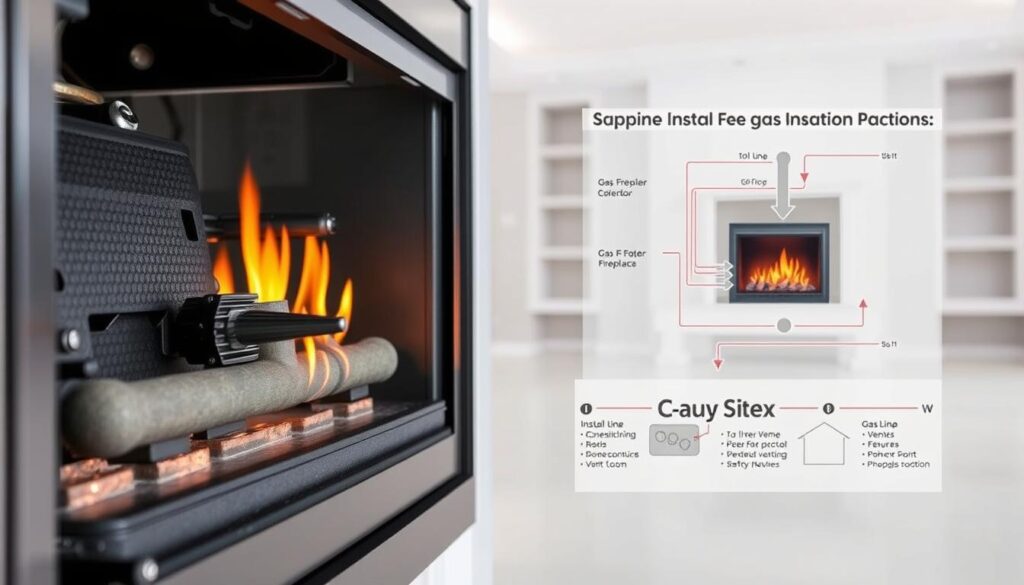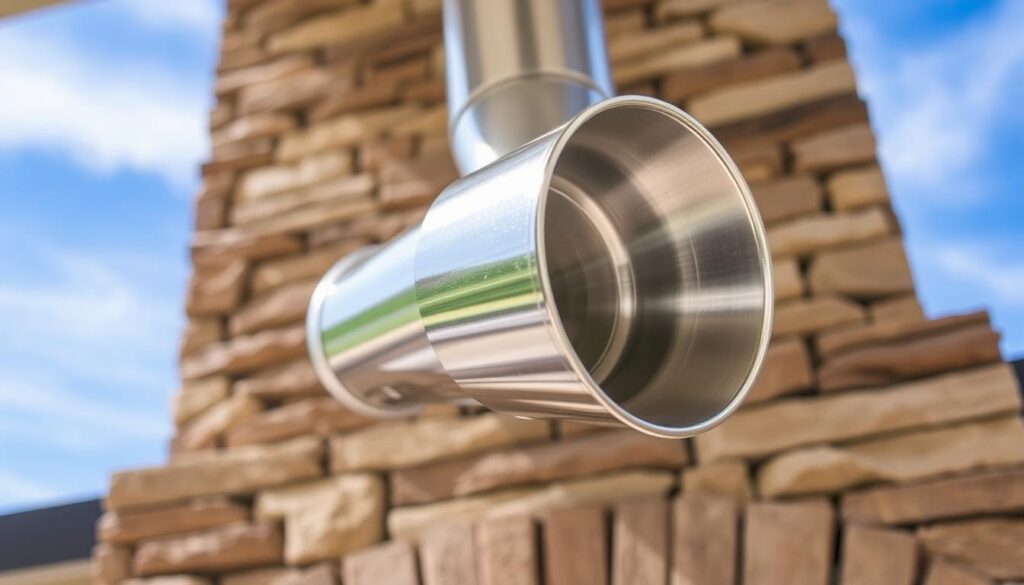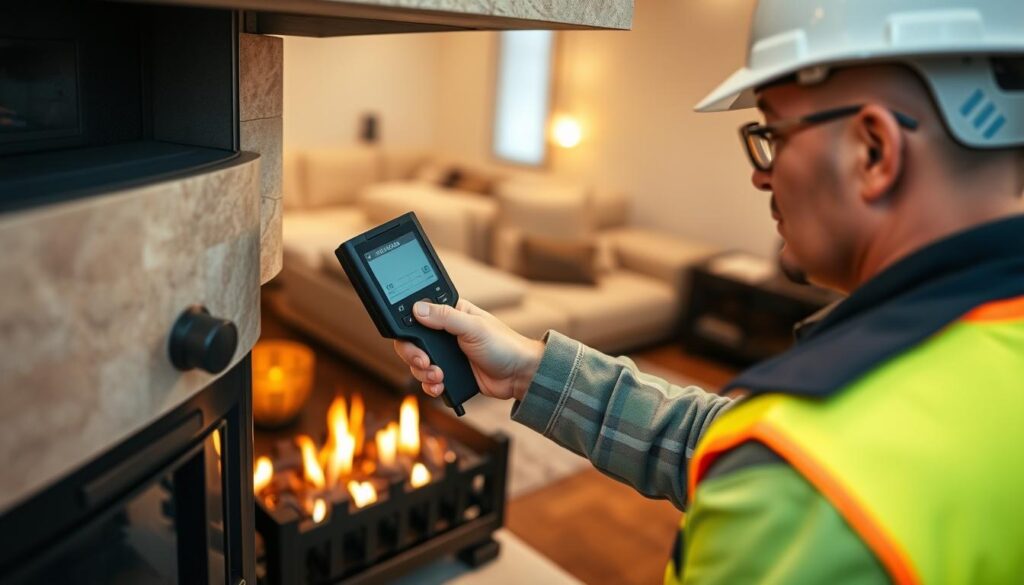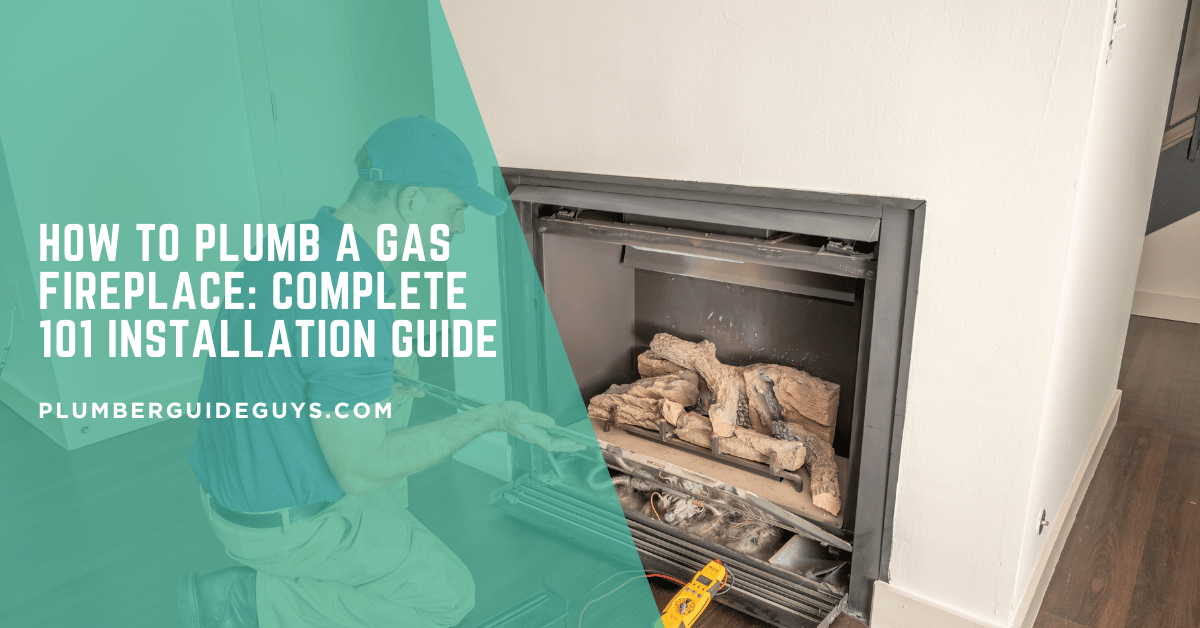Affiliate Disclosure
Plumber Guide Guys is a participant in the Amazon Services LLC Associates Program, an affiliate advertising program designed to provide a means for sites to earn advertising fees by advertising and linking to Amazon.
Are you fed up with heating solutions that cost too much and waste energy? Learning how to plumb a gas fireplace could be the smart home upgrade you need.

Installing a gas fireplace can make your home warm and cozy without the hassle. These fireplaces are efficient and easy to care for, unlike wood-burning ones. With the right steps, you can make your home a snug and energy-saving place.
This detailed guide will cover everything you need to know about gas fireplace installation. You’ll learn about the technical and safety aspects to ensure a job well done.
Key Takeaways
- Learn professional techniques for gas fireplace plumbing
- Understand essential safety protocols and requirements
- Discover cost-effective installation strategies
- Recognize when professional help is necessary
- Gain insights into proper ventilation and gas line connections
Table of Contents
Understanding Gas Fireplace Systems
Gas fireplaces are a modern and efficient way to heat your home. It’s important to know the different systems and their features when installing a natural gas line for your fireplace.
Types of Gas Fireplaces
There are three main types of gas fireplaces for your home:
- Ventless Gas Fireplaces: They don’t need a chimney and use indoor air.
- Vented Gas Fireplaces: They give a traditional fireplace feel.
- Direct Vent Gas Fireplaces: They have a two-layer pipe for air and exhaust.
Key System Components
| Component | Function |
|---|---|
| Gas Valve | Controls gas flow and ignition |
| Burner | Distributes flame across fireplace |
| Venting System | Manages exhaust and air circulation |
| Pilot Light | Provides continuous ignition source |
Safety Considerations
Your gas fireplace system needs careful safety checks. Make sure you have proper ventilation, regular maintenance, and follow local building codes. Always get a professional for gas fireplace plumbing to ensure it’s installed right and safe.
Required Tools and Materials for Installation
Getting ready for gas fireplace installation needs careful planning and the right tools. You’ll need a full set of tools and materials for installing gas fireplace valves and gas pipe installation. This ensures a safe and successful project.
- Pipe wrench
- Adjustable wrench
- Pipe cutter
- Tape measure
- Thread sealant for gas connections
- Pressure testing equipment
For gas pipe installation, you’ll need:
- Black iron gas pipes
- Gas-rated flexible connectors
- Pipe fittings and valves
- Teflon tape
- Safety shut-off valves
| Tool Category | Estimated Cost Range | Importance |
|---|---|---|
| Basic Hand Tools | $50 – $150 | Essential |
| Pressure Testing Kit | $100 – $300 | Critical for Safety |
| Gas Pipe Materials | $75 – $250 | Required for Connection |
Safety tip: Always use materials rated for gas to avoid hazards during installation.
Investing in quality tools and materials is key for a smooth and safe installation. Professional-grade equipment reduces risks and improves overall installation performance.
Professional vs DIY Installation: What You Need to Know
Deciding to install a gas fireplace yourself or hire a pro is a big choice. Connecting a gas line to your fireplace is a job that needs special skills and knowledge.
When choosing between DIY or a pro for your gas fireplace plumbing, several important factors come into play. Knowing these can help you make a choice that ensures safety and meets legal standards.
When to Call a Licensed Contractor
Some situations really need a pro:
- Complex gas line routing
- Challenging home structural modifications
- Limited personal technical experience
- Intricate venting requirements
Legal Requirements and Permits
Local laws often say you need a pro for gas appliances. Most places require:
- Specific permits for gas line changes
- Inspection by certified pros
- Following building and safety codes
Cost Comparisons
| Installation Type | Average Cost | Complexity |
|---|---|---|
| DIY Installation | $500 – $1,500 | High Risk |
| Professional Installation | $1,500 – $5,000 | Low Risk |
Professional gas fireplace plumbing might seem pricey, but it’s worth it for safety and peace of mind. Wrong installation can cause gas leaks, carbon monoxide dangers, and damage to your property.
How to Plumb a Gas Fireplace
Installing a gas fireplace needs careful planning and precision. Start by picking the best location. Choose an outside wall for easier venting and gas line connection.
- Measure the space carefully
- Check local building codes and regulations
- Ensure proper ventilation requirements
- Verify gas line compatibility
Safety is key when working with gas connections. Professional installation is strongly recommended to avoid risks. If you’re doing it yourself, follow these steps:
- Shut off the main gas supply before starting
- Use the right gas fireplace fittings
- Apply pipe thread sealant designed for gas lines
- Double-check all connections for leaks
Your gas line must match the fireplace’s BTU needs. The wrong size can cause problems. Always check the manufacturer’s specs and local codes for the right installation.
Professional tip: When in doubt, always contact a licensed gas technician to complete the installation safely.
Gas Line Installation Requirements
Installing a natural gas line for your fireplace needs careful planning. Your gas pipe installation must follow strict technical standards for safety and performance. Knowing these requirements helps create a reliable and efficient gas fireplace system.
Proper gas line installation involves several key steps. Homeowners and professionals must pay close attention to detail. They must also follow local building codes and safety regulations.
Gas Pipe Sizing Guidelines
Choosing the right pipe size is essential for your gas fireplace. Important factors include:
- Calculate total BTU requirements for your fireplace
- Measure the total length of the gas pipe run
- Determine appropriate pipe diameter based on gas flow needs
- Account for vertical and horizontal pipe configurations
Pressure Testing Procedures
Pressure testing is a vital safety step in gas pipe installation. It helps find leaks and ensures the gas line’s integrity.
- Disconnect all appliances from the gas line
- Use a specialized pressure gauge for testing
- Apply test pressure according to manufacturer specifications
- Monitor pressure for recommended duration
- Check for any pressure drops indicating leaks
Safety Valve Installation
Installing proper safety valves is key to protecting your home and family. Gas line safety features prevent gas-related accidents by allowing for emergency shutdown.
- Install a main shutoff valve near the gas meter
- Use pressure regulators to maintain consistent gas flow
- Implement emergency shut-off mechanisms
- Ensure valves are easily accessible
Remember, professional help is vital for complex gas line installations. While knowing these guidelines is helpful, a licensed contractor ensures your natural gas line meets all safety standards.
Proper Ventilation and Exhaust Setup

Ventilation is key when installing a gas fireplace. The right exhaust setup ensures safety, efficiency, and optimal performance. During installation, several key ventilation factors need careful consideration.
Different types of gas fireplaces need specific ventilation approaches:
- Direct vent systems draw outside air for combustion
- Natural vent fireplaces use existing chimney structures
- Vent-free models require precise room air management
When connecting the gas line to the fireplace, ventilation becomes even more critical. Improper exhaust can lead to dangerous air quality issues and health risks. Professional installers usually recommend following these guidelines:
- Measure precise vent sizing requirements
- Verify manufacturer’s specific clearance recommendations
- Determine appropriate termination points for exhaust
- Check local building code compliance
Your gas fireplace installation must account for airborne particles. Dust, pet hair, and other lightweight materials can cause soot buildup if ventilation is inadequate. Always prioritize professional assessment for safe and efficient system operation.
Proper ventilation isn’t just a recommendation—it’s a critical safety requirement for any gas fireplace system.
Installing Gas Fireplace Valves and Fittings
Choosing the right gas fireplace valves and fittings is key for safe and efficient use. Your fireplace’s performance depends on correct installation and quality parts that fit your system.
When installing gas fireplace valves, several important factors come into play. The installation process needs precise valve selection and fitting connections.
Valve Types and Selection
Gas fireplace fittings vary, each for a different purpose:
- Manual Shut-off Valves: Allow for quick emergency stops
- Thermostatic Valves: Keep the temperature steady automatically
- Smart Control Valves: Let you control the fireplace from afar and monitor it
Connection Methods
Connecting gas fireplace valves needs careful attention. You have to pick between:
- Threaded connections
- Flare fittings
- Compression fittings
Pro Tip: Always use gas-rated fittings and apply the right sealing to avoid leaks.
Choosing the right valves and fittings is vital for your gas fireplace’s safety and efficiency. Make sure to match the parts exactly to your fireplace model and gas type.
Electrical Connections and Wiring Guide
Setting up the electrical parts of your gas fireplace needs careful steps and safety rules. A good DIY gas fireplace setup means knowing the electrical needs of today’s fireplaces.
Before starting any electrical work, you must take critical safety precautions:
- Always turn off power at the circuit breaker
- Use appropriate wire gauges recommended by manufacturers
- Follow local electrical code requirements
- Wear protective electrical safety gear
Modern gas fireplace setups have several important electrical connections:
| Connection Type | Purpose | Typical Voltage |
|---|---|---|
| Ignition System | Electronic pilot light activation | 24V |
| Blower/Fan Control | Heat distribution regulation | 120V |
| Smart Thermostat | Temperature management | 24V |
Your DIY gas fireplace setup will need a special electrical box near the fireplace. Proper grounding is absolutely essential to avoid electrical dangers.
Experts say to use junction boxes made for gas fireplaces. These boxes ensure safe connections and meet strict safety rules for electrical work near gas appliances.
Testing and Safety Checks
After your gas fireplace is installed, it’s important to test it thoroughly. This ensures it works safely and efficiently. It also keeps your home and family safe from gas dangers.

Testing your gas fireplace involves several key steps. These steps help prevent risks and make sure your system works well.
Leak Detection Methods
Finding gas leaks needs careful steps:
- Use soap-water solution to spot small leaks
- Apply electronic gas detectors for accurate readings
- Check all connections carefully
- Make sure pipe joints are strong
Initial Operation Testing
When you first use your gas fireplace, pay attention to these points:
- Make sure the flame lights up right
- Check the flame’s color and shape
- Test the carbon monoxide detectors
- Check if the oxygen depletion sensor works
Regular upkeep and yearly checks by experts can avoid problems. It also makes your gas fireplace last longer.
Safety tip: Always get a licensed pro for detailed gas fireplace plumbing checks.
Maintenance and Regular Inspections
Keeping your gas fireplace in top shape is key. Regular care stops problems before they start. It also makes your fireplace last longer.
Your gas fireplace needs regular checks to work right. Make a routine that covers important tasks:
- Clean the glass surface every three months with a fireplace glass cleaner
- Look for wear or leaks in gas connections
- Check ventilation for blockages
- Change remote control and thermostat batteries every year
“A well-maintained gas fireplace is a safe and efficient fireplace” – Professional HVAC Technicians Association
Getting a yearly check from a pro is a must. They’ll do a deep dive on your fireplace, including:
- Testing gas line pressure
- Checking burner and pilot light
- Ensuring good ventilation
- Cleaning inside parts
Watch for signs that mean you need a pro fast. These include bad smells, uneven flames, or trouble lighting. These could mean your fireplace needs expert help.
Regular maintenance saves money and keeps your fireplace safe and warm for years.
Troubleshooting Common Installation Issues
Setting up a gas fireplace can be tricky, even for DIY experts. Knowing common problems helps keep your fireplace safe and working well. This guide will help you tackle the usual issues you might face.
Identifying Pressure Problems
Pressure issues can really affect your gas fireplace’s performance. Look out for these important signs:
- Weak flame appearance
- Irregular burning patterns
- Unusual noises during operation
To solve pressure problems, check these key parts:
| Component | Potential Issue | Recommended Action |
|---|---|---|
| Gas Regulator | Incorrect pressure setting | Professional pressure adjustment |
| Venturi Tube | Misalignment or blockage | Clean and realign carefully |
| Gas Line | Partial obstruction | Inspect for debris or kinks |
Addressing Connection Leaks
Gas fireplace plumbing needs to be precise. Never ignore possible gas leaks. Here’s how to detect them:
- Apply soap solution to connection points
- Watch for bubble formation indicating gas escape
- Use professional gas leak detector
Resolving Ignition Challenges
Ignition problems can come from many sources. Check electrical connections, pilot light alignment, and make sure safety features work right.
Safety Tip: When in doubt about complex gas fireplace issues, always consult a licensed professional.
Conclusion
Learning to plumb a gas fireplace needs careful planning and technical knowledge. You must also follow safety rules closely. By following the steps in this guide, you can install a gas fireplace with confidence.
Your journey to install a gas fireplace starts with understanding its parts. You’ll need the right tools and techniques. It’s important to know when to call a professional for gas line connections and ventilation.
Remember, safety is key in gas fireplace installation. You must follow local building codes and test the system’s pressure. Making sure connections are done right is also critical for safety and efficiency.
Regular maintenance and professional checks are vital. They keep your gas fireplace working well and last longer. A well-installed gas fireplace adds warmth, beauty, and energy savings to your home.
By learning about installation and getting professional help, you make your home safer and more comfortable. This boosts your home’s value and comfort.
FAQ
How difficult is it to install a gas fireplace myself?
What permits are required for gas fireplace installation?
How much does a gas fireplace installation cost?
How difficult is it to install a gas fireplace myself?
What permits are required for gas fireplace installation?
How much does a gas fireplace installation cost?
FAQ
How difficult is it to install a gas fireplace myself?
Installing a gas fireplace is complex and risky. It’s not just for DIY experts. Safety issues like gas leaks and bad ventilation are big concerns. Unless you know a lot about plumbing and gas lines, it’s best to hire a pro.
What permits are required for gas fireplace installation?
Permits needed vary by area. You’ll likely need:
– Building permit – Mechanical permit – Gas line installation permit
Always check with your local building department before starting.
How much does a gas fireplace installation cost?
Costs range from
FAQ
How difficult is it to install a gas fireplace myself?
Installing a gas fireplace is complex and risky. It’s not just for DIY experts. Safety issues like gas leaks and bad ventilation are big concerns. Unless you know a lot about plumbing and gas lines, it’s best to hire a pro.
What permits are required for gas fireplace installation?
Permits needed vary by area. You’ll likely need:
– Building permit – Mechanical permit – Gas line installation permit
Always check with your local building department before starting.
How much does a gas fireplace installation cost?
Costs range from $1,500 to $5,000. Factors include:
– Fireplace type
– Gas line complexity
– Venting needs
– Local labor rates
– Any extra electrical work
Trying to do it yourself might save money but could be more expensive if you make mistakes.
What are the primary safety concerns with gas fireplace installation?
Safety issues include:
– Preventing gas leaks
– Ensuring proper ventilation
– Correct gas line sizing
– Keeping safe distances from flammable materials
– Having carbon monoxide detectors
– Following local building codes
A pro can make sure all these are done right.
How long does a typical gas fireplace installation take?
It usually takes 4-8 hours. Time depends on:
– Installation complexity
– Existing setup
– Fireplace type
– Gas line and ventilation needs
More complex jobs might take longer.
What maintenance is required after gas fireplace installation?
You should do annual maintenance. This includes:
– Professional inspection
– Cleaning burners
– Checking gas connections
– Verifying ventilation
– Testing safety sensors
– Looking at electrical parts
Most makers suggest a pro for yearly service.
Can I convert my wood fireplace to a gas fireplace?
Conversion is possible but needs a pro’s check. You’ll need to:
– Check chimney fit
– Install gas lines
– Add venting
– Change the fireplace structure
Costs are $2,000 to $6,000, based on the job’s complexity.
What are the most common installation mistakes?
Common errors include:
– Wrong gas line size
– Bad ventilation
– Incorrect valve setup
– Not following maker’s specs
– Ignoring local codes
These mistakes can be dangerous and cause system failures.
,500 to ,000. Factors include:
– Fireplace type
– Gas line complexity
– Venting needs
– Local labor rates
– Any extra electrical work
Trying to do it yourself might save money but could be more expensive if you make mistakes.
What are the primary safety concerns with gas fireplace installation?
Safety issues include:
– Preventing gas leaks
– Ensuring proper ventilation
– Correct gas line sizing
– Keeping safe distances from flammable materials
– Having carbon monoxide detectors
– Following local building codes
A pro can make sure all these are done right.
How long does a typical gas fireplace installation take?
It usually takes 4-8 hours. Time depends on:
– Installation complexity
– Existing setup
– Fireplace type
– Gas line and ventilation needs
More complex jobs might take longer.
What maintenance is required after gas fireplace installation?
You should do annual maintenance. This includes:
– Professional inspection
– Cleaning burners
– Checking gas connections
– Verifying ventilation
– Testing safety sensors
– Looking at electrical parts
Most makers suggest a pro for yearly service.
Can I convert my wood fireplace to a gas fireplace?
Conversion is possible but needs a pro’s check. You’ll need to:
– Check chimney fit
– Install gas lines
– Add venting
– Change the fireplace structure
Costs are ,000 to ,000, based on the job’s complexity.
What are the most common installation mistakes?
Common errors include:
– Wrong gas line size
– Bad ventilation
– Incorrect valve setup
– Not following maker’s specs
– Ignoring local codes
These mistakes can be dangerous and cause system failures.

